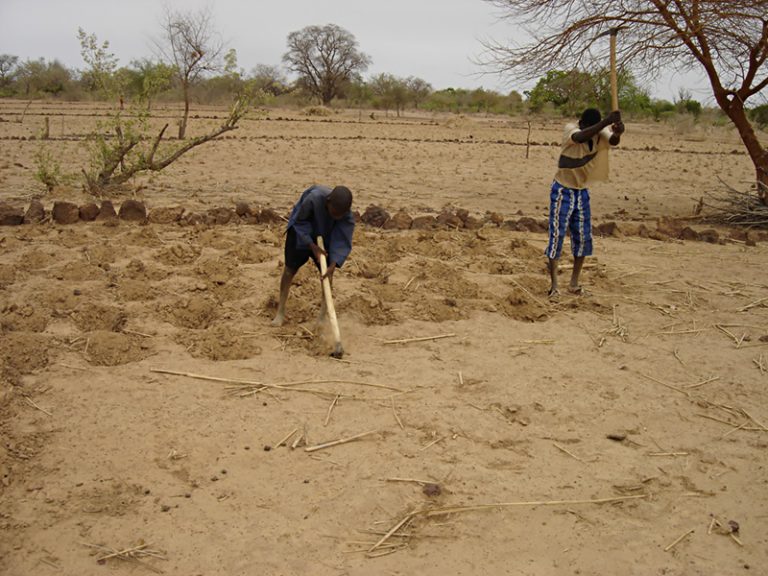Combining ecosystem health with human well-being
An ecological and socio-economic need
For the last one and a half centuries, humanity has been wantonly eating away at its natural reserves. This situation has lead to two world crises that are intricately connected:
An ecological crisis that entails losses in biodiversity and in ecosystem functions at the local, regional and global scales, as well as the shrinking of natural areas. Immediate consequences for mankind are conflicts for the acquisition of resources, and the loss of natural goods and services (e.g., wood supply, natural waste treatment, water purification, carbon sequestration, etc.).
A humanitarian crisis caused by ways of exploiting and sharing natural goods and services that are disadvantageous to the poorest among us. The unjust distribution of riches that arises from this contributes to massively degraded ecosystems everywhere on Earth. This situation is partly favoured by economic globalisation and the access to increasingly remote resources by wealthy people and economies.
Within this context, endeavouring only to preserve natural resources is not enough to guarantee the minimum goods and services needed by people. Ecologically restoring degraded ecosystems is also vain if it is not coupled with the implementation of sustainable exploitation systems and profound changes in our patterns of consumption.
The restoration of natural capital (RNC) reconciles the objectives and imperatives of biodiversity preservation and ecosystem health protection, local production in the short term, as well as long-term, sustainable economic development, both locally and internationally.
Natural capital
Natural capital, a concept developed at the end of the 1970’s, consists of all the sustainable ecosystems and ecological landscapes from which people derive services (e.g., clean air and water, carbon sequestration, waste treatment, etc.) and products (food, fodder, natural fibres, wood, etc.) that improve their well-being without any production cost (Daly and Farley, 2004*). Natural capital is divided into 4 categories:
1. renewable natural capital (living species, ecosystems);
2. non-renewable natural capital (oil, coal, diamonds);
3. recoverable natural capital (atmosphere, drinking water, fertile land);
4. cultivated natural capital (derived from agriculture and forestry, etc.).
This concept allows taking environmental issues into account in economic and political decision-making. It highlights the limiting role of natural resources and ecosystems in the socio-economic development of populations and nations.
*Daly H., Farley J., 2004. Ecological Economics: Principles and Applications. Island Press. Washington, DC.
Restoring natural capital: ecosystem health and human well-being
Restoring natural capital consists of all activities that integrate the increase or investment in natural capital stocks with the aim to expand the flow of natural goods and services while improving aspects related to human well-being.
Like ecological restoration, as defined by the Society for Ecological Restoration International, RNC intends to improve ecosystem health and resilience capacity. But in addition, RNC also strives to meet local people’s socio-economic needs and expectations. Its key message is: “Human populations’ well-being depends on ecosystem health and the quality of derived natural services”.
Natural capital restoration therefore includes (Aronson et al., 2007):
Restoring land and water ecosystems;
Improving, in a sustainable, ecological way, lands subjected to farming practice or other productive activities;
Promoting the sustainable use of biological resources;
Implementing socio-economic activities and behaviour that take into account environmental considerations and the sustainable management of natural capital.
In arid and semi-arid environments, RNC includes ecologically restoring water flows, land fertility, vegetation cover, as well as restoring stable socio-economic networks.
The success of a RNC project depends on how relevant its aims are with regards the socio-economic needs and expectations of local populations. Every project should be designed and programmed according to the local context. Involving local populations is indispensable for such projects to go smoothly. Local interest and support can then be assured and maintained thanks to the direct and indirect benefits derived by local people from RNC.
Why invest in restoring natural capital in arid areas?
Managers of RNC projects are faced with the uncertain and unpredictable character of the restoration process, as well as with the need to enhance the often long-term, intangible benefits of restoration. In addition, financially assessing natural capital is not easy. Actually, many natural services are ‘priceless’ in the figurative sense —since they are indispensable to life on Earth— just as they are in the literal sense, since they currently have no value in economic markets. This makes it difficult to justify investing in RNC projects, and to assess their success short term. However, new economic tools are being developed to evaluate, justify, and support investment in RNC . Additionally, multi-criteria assessment techniques have been developed for assessment.
They comprise three steps:
Working with the various parties concerned in order to define project goals, the various success criteria to be used, and the relative importance (weighting) of assessment criteria;
Deciding on strategies to reach objectives, assessing how each strategy meets the success criteria established, and selecting the best one;
Classifying the various options and helping carry out the final strategy.
RNC projects can involve mixed (public and private) investment. The share of public funding can be provided through national taxes and duties. Identifying and motivating private partners depends on determining who stands to benefit from the project locally. There are several ways of taking part in such projects, such as associating in management and other activities in the field and/or funding/sponsoring equipment.
Two kinds of funding mechanisms are involved in restoration: those based on the ‘polluter pays’ principle and those based on the ‘beneficiary pays’ concept. Costs are sometimes shared between the two categories. The final decision is a political one that depends on the various expectations of each of the communities concerned, as well as on the prevailing economic power.
At first sight, it seems more profitable to invest in methods of sustainable exploitation rather than to restore what has been degraded. Nevertheless, while awaiting a policy for the sustainable management of resources, the RNC approach allows to associate human interests with the benefits of a sustainable relationship between humans and their environment.


